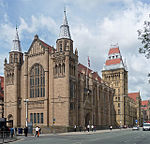Department of Materials, University of Manchester
Departments of the University of ManchesterMaterials science institutesPages containing links to subscription-only content

The Department of Materials, at the University of Manchester is an academic and research department specialising in Materials Science and Engineering and Fashion Business and Technology. It is the largest materials science and engineering department in Europe. This is reflected by an annual research income of around £7m, 60 academic staff, and a population of 150 research students and 60 postdoctoral research staff. The Department of Materials was formerly known as the School of Materials until a faculty-wide restructuring in 2019.
Excerpt from the Wikipedia article Department of Materials, University of Manchester (License: CC BY-SA 3.0, Authors, Images).Department of Materials, University of Manchester
Oxford Road, Manchester Chorlton-on-Medlock
Geographical coordinates (GPS) Address Website Nearby Places Show on map
Geographical coordinates (GPS)
| Latitude | Longitude |
|---|---|
| N 53.4676 ° | E -2.2343 ° |
Address
University of Manchester
Oxford Road
M13 9PL Manchester, Chorlton-on-Medlock
England, United Kingdom
Open on Google Maps











